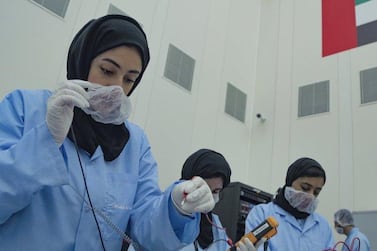When you think of America's space race, Neil Armstrong and Buzz Aldrin come to mind.
But without the efforts of Nasa's unknown engineers, that giant leap for mankind may not have happened for the US.
One of Nasa's forgotten legends is Mary Winston Jackson, its first African-American female engineer.
Jackson's work was pivotal in making those first small steps for mankind become a reality and now Nasa has honoured her work by naming its Washington headquarters after her.
“Mary W Jackson was part of a group of very important women who helped Nasa succeed in getting American astronauts into space," Nasa administrator Jim Bridenstine said.
"Mary never accepted the status quo. She helped to break barriers and open opportunities for African-Americans and women in the field of engineering and technology.
Our headquarters building in Washington, D.C., will be named after Mary W. Jackson, the first African-American female engineer at NASA. She started in @NASAaero research and later moved into the personnel field, working to ensure equal opportunity in hiring and promotion. pic.twitter.com/eMandeaMyv
— NASA (@NASA) June 24, 2020
“Today, we proudly announce the Mary W Jackson Nasa Headquarters building.
"It appropriately sits on Hidden Figures Way, a reminder that Mary is one of many incredible and talented professionals in Nasa’s history who contributed to this agency’s success.
"Hidden no more, we will continue to recognise the contributions of women, African-Americans, and people of all backgrounds who have helped to construct Nasa’s successful history to explore.”
Jackson's journey to becoming one of Nasa's greats was not easy but she overcame the barriers of segregation and gender bias to become a professional aerospace engineer and leader in ensuring equal opportunities for future generations.
She started her career at the agency in the segregated West Area Computing Unit of its Langley Research Centre in Hampton, Virginia.
A talented mathematician and aerospace engineer, she went on to lead programmes influencing the hiring and promotion of women in Nasa's science, technology, engineering and mathematics careers.
In 2019, she was posthumously awarded the Congressional Gold Medal.
“We are honoured that Nasa continues to celebrate the legacy of our mother and grandmother, Mary W Jackson,” said her daughter, Carolyn Lewis.
“She was a scientist, humanitarian, wife, mother and trailblazer who paved the way for thousands of others to succeed, not only at Nasa but throughout this nation.”
Jackson's story was brought to life in the 2016 book by Margot Lee Shetterly, Hidden Figures: The American Dream and the Untold Story of the Black Women Mathematicians Who Helped Win the Space Race.
The book was made into a movie that year and her character was played by award-winning actress Janelle Monae.
Jackson was born and raised in Hampton, Virginia. She graduated from Hampton Institute in 1942 with a dual degree in maths and physical sciences, and initially accepted a job as a maths teacher in Calvert County, Maryland.
She married and started a family and was working as a secretary for the US Army before her aerospace career took off.
In 1951, she was recruited by the National Advisory Committee for Aeronautics, which in 1958 was succeeded by Nasa.
Jackson started as a research mathematician who became known as one of the human computers at Langley.
Mary Jackson worked as a mathematician at @NASA_Langley, where she was promoted to become our first Black woman engineer.
— Women@NASA (@WomenNASA) June 24, 2020
Today we announced that our HQ in D.C. will be renamed the Mary W. Jackson NASA Headquarters Building, in honor of her legacy: https://t.co/Nx8iGflzXZ pic.twitter.com/fDJNA0lTbM
She worked under fellow “hidden figure” Dorothy Vaughan in the segregated West Area Computing Unit.
After two years in the computing pool, she received an offer to work in the 1.2-metre by 1.2-metre Supersonic Pressure Tunnel, a 60,000-horsepower wind tunnel capable of blasting models with winds approaching twice the speed of sound.
It was there she received hands-on experience in conducting experiments.
Jackson's supervisor eventually suggested she enter a training programme that would allow her to earn a promotion from mathematician to engineer.
Because the classes were held at the then-segregated Hampton High School, she needed special permission to join her white peers in the classroom.
Jackson completed the courses, earned the promotion, and in 1958 became Nasa’s first black female engineer.
For nearly two decades during her engineering career, she authored or co-authored research reports, mostly focused on the behaviour of the boundary layer of air around airplanes.
In 1979, she joined Langley’s Federal Women’s Programme, where she worked hard to address the hiring and promotion of the next generation of female mathematicians, engineers and scientists.
Jackson retired from Langley in 1985.
Last year, US President Donald Trump signed the Hidden Figures Congressional Gold Medal Act that posthumously awarded the honour to Jackson, who died in 2005.
Her colleagues, Katherine Johnson, Dorothy Vaughan and Christine Darden, also received the award.
“Nasa facilities across the country are named after people who dedicated their lives to push the frontiers of the aerospace industry," Mr Bridenstine said.
"The nation is beginning to awaken to the greater need to honour the full diversity of people who helped pioneer our great nation.
"Over the years Nasa has worked to honour the work of these hidden figures in various ways, including naming facilities, renaming streets and celebrating their legacy.
“We know there are many other people of colour and diverse backgrounds who have contributed to our success, which is why we are continuing the conversations started about a year ago with the agency’s Unity Campaign.
"Nasa is dedicated to advancing diversity and we will continue to take steps to do so.”








